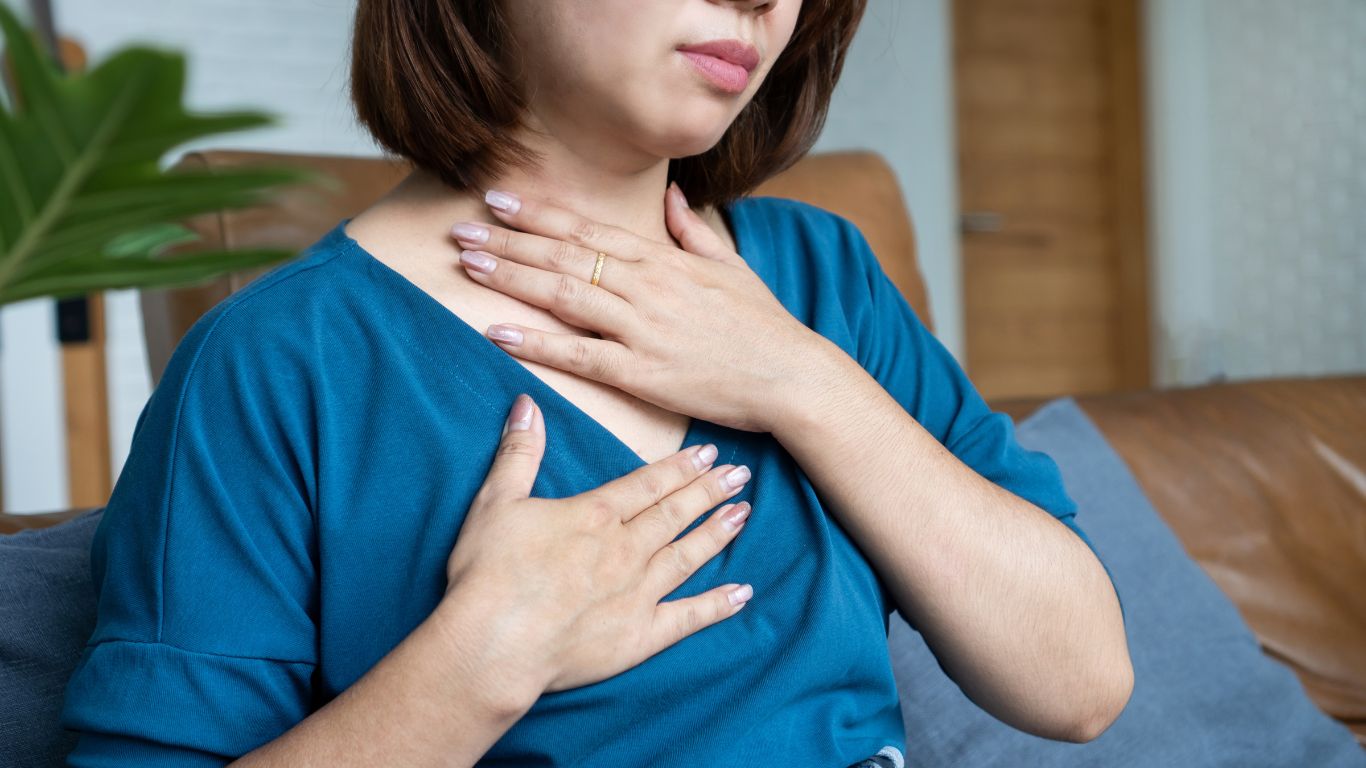Best GERD-Friendly Diet for Weight Loss: Eat Smart & Feel Better!
If you’ve ever tried to lose weight while dealing with GERD, you know the struggle is real. Finding a GERD-friendly diet for weight loss that won’t leave you clutching your chest in agony is a challenge. I’ve been there—eager to shed a few pounds but terrified of triggering acid reflux. Through trial and error (and a whole lot of heartburn), I finally found a way to make it work. So, let’s talk about how to lose weight without setting your esophagus on fire.
Understanding the GERD-Weight Connection

Most people don’t realize that extra weight—especially around the belly—can make GERD symptoms worse. That’s because excess fat puts pressure on your stomach, pushing acid up into your esophagus. Trust me, I learned this the hard way. The heavier I got, the worse my reflux became. But losing weight? That changed everything.
How Excess Weight Triggers Acid Reflux
When you carry extra weight, especially in the abdominal area, it increases intra-abdominal pressure. This pressure can cause the lower esophageal sphincter (LES) to weaken or open up at the wrong times, allowing stomach acid to creep back up. The result? That burning sensation we all know too well.
Why Standard Diets Don’t Work for GERD
Traditional weight loss diets often include acidic, spicy, or fatty foods that can be a disaster for reflux sufferers. I once tried a high-protein, low-carb diet that relied heavily on coffee, citrus, and spicy foods—let’s just say, I spent more time popping antacids than burning calories.
Key Principles of a GERD-Friendly Diet for Weight Loss

So, what works? Over the years, I’ve discovered some essential rules to keep both weight loss and reflux in check. Here’s what I recommend:
1. Choose Alkaline and Low-Acid Foods
Avoiding acidic foods is a game-changer. Instead, focus on foods that balance stomach acidity and reduce reflux triggers.
- Best choices: Oatmeal, bananas, melons, green vegetables, brown rice, and lean proteins.
- Avoid: Citrus fruits, tomatoes, vinegar-based dressings, and fried foods.
2. Eat Smaller, Frequent Meals
One of the biggest mistakes I used to make was skipping meals and then eating a large portion all at once. That’s a recipe for disaster. Now, I eat smaller meals every 3-4 hours to keep my stomach from getting too full and pushing acid up.
3. Cut Back on High-Fat Foods
Fatty foods sit in your stomach longer, which increases the chance of reflux. Stick to healthy fats like avocado, olive oil, and nuts in moderation.
4. Limit Caffeine and Carbonated Beverages
I used to live off coffee, but every sip felt like pouring acid directly into my throat. Swapping it for herbal teas and alkaline water made a world of difference.
Smart Meal Planning for GERD and Weight Loss

The key to success is planning meals that won’t trigger reflux while keeping calories in check. Here’s how I structure my meals:
Breakfast
- Oatmeal with almond milk and sliced bananas
- Scrambled egg whites with whole-grain toast
Lunch
- Grilled chicken with quinoa and steamed broccoli
- Hummus with whole-grain pita and cucumber slices
Dinner
- Baked salmon with roasted sweet potatoes
- Turkey and spinach wrap with a side of cooked carrots
Snacks
- Almonds (in small portions)
- Greek yogurt (non-fat and plain)
Sticking to these types of meals helped me not only lose weight but also keep my GERD symptoms in check. Up next, we’ll dive into the best GERD-friendly exercises, lifestyle tips, and how to maintain long-term success.
Best Exercises for GERD-Friendly Weight Loss

Now that we’ve covered what to eat, let’s talk about another crucial factor in weight loss: exercise. But if you have GERD, you can’t just jump into any high-intensity workout and expect smooth sailing. Trust me, I’ve learned this the hard way—one too many crunches and I was practically begging for relief from acid reflux.
1. Low-Impact Cardio is Your Best Friend
Cardio is essential for burning calories, but some types can worsen GERD. Running, for example, used to leave me gasping, not from exhaustion, but from acid creeping up my throat. Instead, I switched to lower-impact options, and what a difference it made.
- Best choices: Brisk walking, cycling, swimming, or using an elliptical machine.
- Avoid: Sprinting, jumping exercises, or anything that involves sudden, intense movements.
2. Strength Training Without the Strain
Strength training is fantastic for building muscle and boosting metabolism, but heavy lifting can put extra pressure on your abdomen, which isn’t ideal for GERD. I learned to modify my workouts to keep reflux at bay.
- Stick to moderate weights and focus on higher reps.
- Avoid exercises that involve bending or lying flat, like bench presses or crunches.
- Seated or standing exercises are usually safe options.
3. Yoga and Pilates for Core Strength
You might think that yoga and Pilates are all about twisting and bending (which can aggravate GERD), but many poses actually help with digestion and core stability without causing reflux.
- Good poses: Cat-Cow, Warrior I & II, and standing poses.
- Avoid: Downward-facing dog, deep twists, and any pose that puts pressure on the abdomen.
Eating Habits That Prevent GERD Flare-Ups

It’s not just what you eat—it’s how you eat. I used to rush through meals, eating whatever I could grab between work and errands. Big mistake. Once I started paying attention to my eating habits, my GERD symptoms improved dramatically.
1. Eat Slowly and Chew Thoroughly
This might sound simple, but it’s a game-changer. When you eat too fast, you swallow more air, which can lead to bloating and acid reflux. Plus, well-chewed food is easier for your stomach to digest.
2. Avoid Eating Right Before Bed
I used to enjoy late-night snacks while watching TV, but my reflux didn’t. Lying down too soon after eating is a recipe for disaster. Now, I make sure to finish dinner at least three hours before bedtime.
3. Stay Upright After Meals
Speaking of positioning, staying upright after eating can make a huge difference. If I need to relax, I opt for sitting in a reclined position rather than lying completely flat.
Hydration Tips: What to Drink and Avoid

Drinks matter just as much as food when it comes to managing GERD. I used to guzzle coffee and carbonated drinks without a second thought—until I realized they were some of my worst triggers.
1. Stick to Alkaline Water
Alkaline water has a higher pH level, which can help neutralize stomach acid. I always keep a bottle on hand, especially when I know I’ll be out for long periods.
2. Herbal Teas for Digestive Support
Some teas are actually soothing for GERD. My personal favorites are:
- Ginger tea – Helps with digestion and nausea.
- Chamomile tea – Calming and gentle on the stomach.
- Licorice root tea – Known to help coat and protect the esophagus.
3. What to Avoid
There are certain drinks I’ve learned to stay away from completely:
- Coffee and caffeinated teas – These relax the lower esophageal sphincter, making reflux worse.
- Carbonated beverages – The bubbles create gas and pressure, pushing acid upwards.
- Alcohol – Wine, beer, and spirits all tend to irritate the stomach lining.
Making these hydration swaps was one of the easiest ways I improved my GERD symptoms while staying on track with my weight loss goals. Next, let’s talk about lifestyle tweaks that make all the difference.
Simple Lifestyle Tweaks to Manage GERD While Losing Weight

By now, we’ve covered the best GERD-friendly diet for weight loss, meal planning, and exercise strategies, but there’s one more piece of the puzzle—your lifestyle. I used to think just eating right and working out was enough, but small daily habits had an even bigger impact on my reflux symptoms.
1. Adjust Your Sleeping Position
If you’ve ever woken up in the middle of the night with that awful burning sensation, you know how much GERD can ruin sleep. I found that simply raising the head of my bed by a few inches made a massive difference.
- Use a wedge pillow or elevate the head of your bed by 6-8 inches.
- Try sleeping on your left side—this keeps your stomach below your esophagus, reducing reflux.
- Avoid sleeping flat on your back or right side, as this can make symptoms worse.
2. Manage Stress (Because It’s a Huge Trigger!)
Let’s be real—stress affects everything, including GERD. I used to get reflux flare-ups every time I was overwhelmed with work or personal life. Turns out, stress increases stomach acid production and weakens digestion.
Here’s what helped me manage stress and keep reflux in check:
- Deep breathing exercises – Just 5 minutes of focused breathing helped me calm down.
- Daily walks – A short walk after meals improved my digestion and eased stress.
- Journaling – Writing down my thoughts and worries helped me process stress in a healthy way.
- Limiting screen time before bed – Less scrolling, more sleep!
3. Wear the Right Clothes
This might sound strange, but tight clothing—especially around the waist—can make reflux worse. I used to wear snug jeans all the time, not realizing they were increasing pressure on my stomach.
Now, I opt for:
- Looser-fitting clothes, especially after meals.
- High-waisted leggings instead of tight waistbands when working out.
- Comfortable fabrics that don’t press on my stomach.
How to Stay Consistent with a GERD-Friendly Weight Loss Plan

Let’s be honest—sticking to any diet or lifestyle change is hard. Add GERD to the mix, and it can feel overwhelming. I’ve had my fair share of slip-ups, but what really helped me stay on track was focusing on progress, not perfection.
1. Track Your Triggers
One of the best things I did was start a food and symptom journal. It helped me pinpoint exactly which foods, habits, and situations triggered my reflux.
Here’s how you can do it:
- Write down what you eat and how you feel afterward.
- Track exercise intensity and note any reflux symptoms.
- Keep notes on stress levels and sleep quality.
After a few weeks, patterns will start to emerge, making it easier to tweak your diet and routine.
2. Plan Ahead for Social Events
Eating out or going to events used to make me anxious because I never knew what foods would be available. Now, I plan ahead and make smart choices.
- Check the menu beforehand and choose GERD-friendly options.
- Eat a small meal before heading out to avoid overindulging.
- Skip trigger foods like fried appetizers and acidic cocktails.
- Bring antacids just in case.
3. Be Patient with Weight Loss
GERD-friendly weight loss isn’t about crash dieting—it’s about sustainable, healthy changes. I used to get frustrated when the scale didn’t move fast enough, but I reminded myself that consistency was more important than quick results.
Focus on:
- Listening to your body and avoiding trigger foods.
- Staying active with low-impact exercises.
- Making small, gradual changes instead of extreme diet shifts.
The weight may come off slowly, but keeping your reflux under control is worth it!
Final Thoughts
Finding a GERD-friendly diet for weight loss isn’t always easy, but it’s absolutely possible. By focusing on the right foods, making smart lifestyle choices, and being patient with the process, you can lose weight while keeping acid reflux at bay.
My biggest advice? Don’t get discouraged. Every small step you take toward better health adds up. Your body (and your esophagus!) will thank you in the long run.
References
- Mayo Clinic – GERD Management Tips
- National Institute of Diabetes and Digestive and Kidney Diseases – Understanding GERD
- Harvard Health – Diet and Acid Reflux
Disclaimer
This article is for informational purposes only and should not be considered medical advice. Always consult with a healthcare professional before making any significant dietary or lifestyle changes, especially if you have GERD or other digestive conditions.

Camellia Wulansari is a dedicated Medical Assistant at a local clinic and a passionate health writer at Healthusias.com. With years of hands-on experience in patient care and a deep interest in preventive medicine, she bridges the gap between clinical knowledge and accessible health information. Camellia specializes in writing about digestive health, chronic conditions like GERD and hypertension, respiratory issues, and autoimmune diseases, aiming to empower readers with practical, easy-to-understand insights. When she’s not assisting patients or writing, you’ll find her enjoying quiet mornings with coffee and a medical journal in hand—or jamming to her favorite metal band, Lamb of God.






